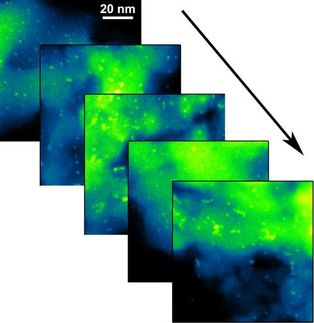An alternative to platinum: Iron-nitrogen compounds as catalysts in graphene
Fuel cells convert the chemical energy stored in hydrogen (H2) into electrical energy by electrochemically "combusting" hydrogen gas with oxygen (O2) from the air into water (H2O), thereby generating electricity. As a result, future electric automobiles might be operated quite well with fuel cells instead of with heavy batteries. But for "cold" combustion of hydrogen and oxygen to function well, the anode and cathode of the fuel cell must be coated with extremely active catalysts. The problem is that the platinum-based catalysts employed for this contribute about 25 per cent of the total fuel-cell costs.

Nano-island of graphene in which iron-nitrogen complexes are embedded. The FeN4 complexes (shown in orange) are catalytically active.
S. Fiechter / HZB
However, iron-nitrogen complexes in graphene (known as Fe-N-C catalysts) have been achieving levels of activity comparable to Pt/C catalysts for several years already. "Systematic investigation of Fe-N-C catalysts was difficult though, since most approaches for preparing the materials lead to heterogeneous compounds. These contain various species of iron compounds such as iron carbides or nitrides besides the intended FeN4 centres", explains Sebastian Fiechter of HZB.
High density of catalytically active centres
"We had already developed a new preparation method at HZB a few years ago to produce an inexpensive catalyst material from organometallic compounds such as iron or cobalt porphyrin", reports Peter Bogdanoff, HZB. Ulrike Kramm and Iris Herrmann-Geppert improved the process for producing it as part of their doctoral studies at HZB. As a result, the metal-N-C catalysts developed at HZB held the world record for the highest density of catalytically active centres of various nitro-metallic compounds up to about 2011. However, it remained unclear as to which inorganic compounds influenced the catalytic efficiency. The team was now able to determine this.
Purification process removes interfering compounds
The highlight in the current work is a purification process (a combination of thermal treatment with a subsequent etching step) by which the proportion of metallic compounds that interfere with catalytic activity can be substantially reduced, even for catalysts that are highly heterogeneous. The interesting thing here is that the activity increases enormously! Ulrike Kramm, who has since become a junior professor at TU Darmstadt, was successful in purifying several catalysts to such an extent that all the iron present in the graphene layers was exclusively in form of complexes made of iron and four nitrogen atoms (FeN4). The scientists thereby disproved the hypothesis debated among experts by which improvement in the activity of the FeN4 centres only resulted from promoters, as they are known, such as iron nanoparticles.
Now verified: FeN4 centres provide the high catalytic efficiency even without promoters
"To check this hypothesis, we employed numerous complex measurement techniques like Mößbauer spectroscopy, electron paramagnetic resonance spectroscopy and X-ray absorption spectroscopy at BESSY II. These enabled us to precisely survey the atomic structure of the catalytic centres", Ulrike Kramm reports.
"The purification process enables us now to create catalysts having exclusively FeN4 centres. This allows us to subsequently select compounds to be added afterwards as promoters that further improve the activity level or stability of these catalysts", as Ulrike Kramm summarises her research approach at TU Darmstadt.
Original publication
Other news from the department science
Most read news
More news from our other portals
See the theme worlds for related content
Topic World Spectroscopy
Investigation with spectroscopy gives us unique insights into the composition and structure of materials. From UV-Vis spectroscopy to infrared and Raman spectroscopy to fluorescence and atomic absorption spectroscopy, spectroscopy offers us a wide range of analytical techniques to precisely characterize substances. Immerse yourself in the fascinating world of spectroscopy!

Topic World Spectroscopy
Investigation with spectroscopy gives us unique insights into the composition and structure of materials. From UV-Vis spectroscopy to infrared and Raman spectroscopy to fluorescence and atomic absorption spectroscopy, spectroscopy offers us a wide range of analytical techniques to precisely characterize substances. Immerse yourself in the fascinating world of spectroscopy!



























































